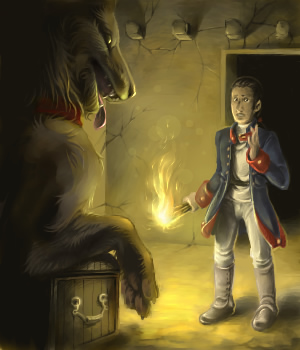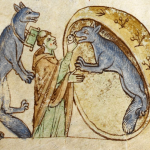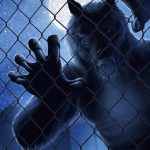
Loup-garou is prevalent in France, with the Beast of Gevaudan being the most famous documented case. The biscalavret is a werewolf that cannot return to human form unless it can put its clothing back on. The lubins or lupins were usually female and shy in contrast to the aggressive loup-garous
In Marie de France’s poem Bisclaveret (c. 1200), the nobleman Bisclavret, for reasons not described in the lai, had to transform into a wolf every week. When his treacherous wife stole his clothing, needed to restore his human form, he escaped the king’s wolf hunt by imploring the king for mercy, and accompanied the king thereafter.
His behavior at court was so gentle and harmless than when his wife and her new husband appeared at court, his attack on them was taken as evidence of reason to hate them, and the truth was revealed.
Others of this sort were the hero of William and the Werewolf (translated from French into English about 1350), and the numerous princes and princesses, knights and ladies, who appear temporarily in beast form in the German fairy tales, or Märchen. See Snow White and Rose Red, where the tame bear is really a bewitched prince.
Certainly the famous Pierre Vidal, the Don Quixote of Provençal troubadours, must have had a touch of this madness, when, after having fallen in love with a lady of Carcassone, named Loba, or the Wolfess, the excess of his passion drove him over the country, howling like a wolf, and demeaning himself more like an irrational beast than a rational man.
He commemorates his lupine madness in the poem A tal Donna:
Crowned with immortal joys I mount
The proudest emperors above,
For I am honoured with the love
Of the fair daughter of a count.
A lace from Na Raymbauda’s hand
I value more than all the land
Of Richard, with his Poïctou,
His rich Touraine and famed Anjou.
When loup-garou the rabble call me,
When vagrant shepherds hoot,
Pursue, and buffet me to boot,
It doth not for a moment gall me;
I seek not palaces or halls,
Or refuge when the winter falls;
Exposed to winds and frosts at night,
My soul is ravished with delight.
Me claims my she-wolf (Loba) so divine:
And justly she that claim prefers,
For, by my troth, my life is hers
More than another’s, more than mine.
[1. BRUCE WHYTE: Histoire des Langues Romaines, tom. ii. p. 248.]
In the south of France, it is still believed that fate has destined certain men to be lycanthropists that they are transformed into wolves at full moon.
The desire to run comes upon them at night. They leave their beds, jump out of a window, and plunge into a fountain. After the bath, they come out covered with dense fur, walking on all fours, and commence a raid over fields and meadows, through woods and villages, biting all beasts and human beings that come in their way. At the approach of dawn, they return to the spring, plunge into it, lose their furry skins, and regain their deserted beds.
Sometimes the loup-garou is said to appear under the form of a white dog, or to be loaded with chains; but there is probably a confusion of ideas between the were-wolf and the church-dog, bar-ghest, pad-foit, wush-hound, or by whatever name the animal supposed to haunt a churchyard is designated.
In the Périgord, the were-wolf is called louléerou. Certain men, especially bastards, are obliged at each full moon to transform themselves into these diabolic beasts.
It is always at night that the fit comes on. The lycanthropist dashes out of a window, springs into a well, and, after having struggled in the water for a few moments, rises from it, dripping, and invested with a goatskin which the devil has given him. In this condition, the louléerous run upon four legs, pass the night in ranging over the country, and in biting and devouring all the dogs they meet. At break of day they lay aside their goatskins and return home. Often they are ill in consequence of having eaten tough old hounds, and they vomit up their undigested paws. One great nuisance to them is the fact that they may be wounded or killed in their louléerou state. With the first effusion of blood their diabolic covering vanishes, and they are recognized, to the disgrace of their families.
A were-wolf may easily be detected, even when devoid of his skin; for his hands are broad, and his fingers short, and there are always some hairs in the hollow of his hand.
In Normandy, those who are doomed to be loups-garoux, clothe themselves every evening with a skin called their hère or hure, which is a loan from the devil. When they run in their transformed state, the evil one accompanies them and scourges them at the foot of every cross they pass. The only way in which a werewolf can be liberated from this cruel bondage, is by stabbing him three times in the forehead with a knife. However, some people less addicted to allopathic treatment, consider that three drops of blood drawn by a needle, will be sufficient to procure release.
According to an opinion of the vulgar in the same province, the loup-garou is sometimes a metamorphosis forced upon the body of a damned person, who, after having been tormented in his grave, has torn his way out of it. The first stage in the process consists in his devouring the cerecloth which enveloped his face; then his moans and muffled howls ring from the tomb, through the gloom of night, the earth of the grave begins to heave, and at last, with a scream, surrounded by a phosphorescent glare, and exhaling a fœtid odour, he bursts away as a wolf.
In Le Bessin, they attribute to sorcerers the power of metamorphosing certain men into beasts, but the form of a dog is that principally affected by them.








